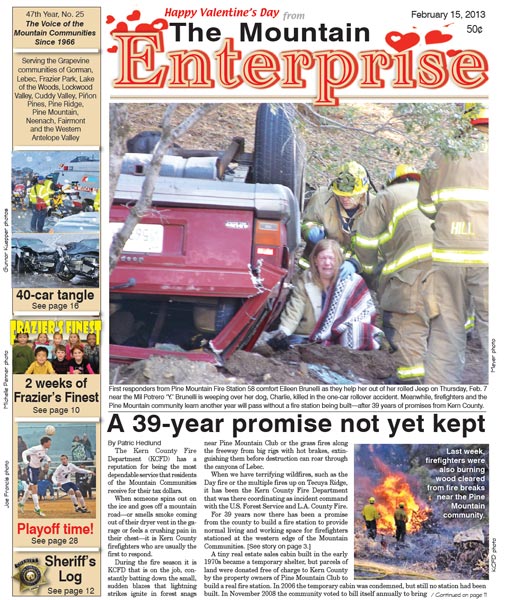Part 2: The local connection
By Patric Hedlund, Editor of The Mountain Enterprise
It became taboo to joke about guns and hijacking on airplanes and in airports when hijacking became a real threat to the public. Perhaps something similar is happening today in schools as we seek to prevent shootings.
In most schools today, there are zero tolerance policies about bringing weapons to schools. But what about making violent threats? A public discussion about these policies is rarely held. Does a school have a responsibility to keep victims of violent threats and their parents fully informed that they have been targeted? Or do they hide that from the public?
The shooter at Taft Union High School will be tried for attempted murder as an adult. If that same level of accountability had been activated when he first made verbal threats about murdering other students, would the shooting have taken place?
Do schools have a responsibility to inform the parents of threat victims of the measures being taken to ensure their child’s safety? And shouldn’t the name of the student making the threat be revealed?
Should school districts ask parents to sign an acknowledgement at the beginning of the school year that violence or the threat of violence by a student is not covered by a right to confidentiality?
In a country saturated with 300,000,000 firearms, where family guns are the most frequent source of weapons used in school shootings, should threats of violence by a student trigger a requirement for disclosure by the family about how their guns are secured to keep them from the hands of a potentially unstable and angry minor?
Are Ed Code ‘confidentiality’ claims being misused by sluggish school administrations as a smokescreen for inaction? Do parents have a right to the full facts about measures being taken by the school to maintain a safe and secure environment for learning?
Last week we wrote about attorney Daniel Rodriguez, who is taking legal action on behalf of the family of Bowe Cleveland, the student who was critically wounded with a shotgun by another student on January 10 at Taft High School.
Rodriguez says it will take a court order to obtain information about the school’s actions in response to violent threats.
Current school policies often appear to protect the rights of perpetrators more than the rights of victims. This is wrong and needs to be addressed.
Cleveland’s family wants to know: Did Bryan Oliver write up a ‘hit list’ earlier in the school year? Did the school expel or suspend him? Did the school seek to learn if guns were owned by the boy or his family? Did they ask how the guns were secured to keep them from a troubled youth’s reach? Did the school take action to alert the parents of all the students whose names were on the hit list, so parents could make informed decisions about the danger their children might face?
These questions about what actions were taken by the school to protect students at risk are not being answered, the family’s attorney said.
What is known is that Oliver was allowed to return to school and that shortly after returning he brought a gun with him and began shooting at other students.
School authorities often use "confidentiality" claims to protect the student making threats rather than taking steps to protect students being threatened.
It could have been here
There are haunting echoes in Taft’s story with what happened at Frazier Mountain High School in the fall of 2010. That was a long drama that eventually ended in the death of a young person by gunshot.
On September 21, 2010 an FMHS student used an online chatboard to threaten a former girlfriend. In a transcript of the threat, seen by The Mountain Enterprise, he said he would kill himself if she did not "come back to him."
Then he escalated the threats, saying he would also kill another student, Sean Parsons, "because I can." Parsons was a platonic friend participating in the FMHS Drumline along with the girl.
The girl was distressed. There were guns in her former boyfriend’s home. Emotional, she asked her mother to come look at what was being said.
Her family took the threat seriously, so they quickly notified the parents of the young man whose life had been threatened. They also called the sheriff’s office.
A deputy came to the girl’s home to pick up a printout of the suicide and murder threat, then went to the home of the student who had made the threats. But the deputy did not call back to inform the girl’s family about what had happened. She, her parents, her Drumline friend and his family were all left sitting up through much of the night in anxiety with no information about what the deputy found or did.
"I didn’t sleep all night after hearing he said he was going to kill me," said Sean Parsons, then 18, the student whose life had been threatened.
As he got off the school bus the next day, the very first person he saw was the student who had threatened to kill him the night before. Parsons said he was shaking with emotion. He went immediately to the school office to tell then-Principal Dan Penner what had happened less than 12 hours earlier. Again deputies arrived. The threatening student’s parents were called. He was suspended for five days. But the student drove his own car home that day, while the parents drove back to work in opposite directions, the girls’ father said, who happened to be at the stop sign at Falcon Way as the boy drove home alone.
"He appeared to be unsupervised," the father said, concerned that the student was going back alone to a home which family friends say contained guns.
Sean Parson’s family called the newspaper because of the secretive procedures of Frazier Mountain High School.
Citing "confidentiality," the district refused to tell the anxious parents whether the student making the threats was receiving counseling intervention or whether the family guns had been taken out of the home.
To protect the confidentiality of the student who made the threats, two families were left in limbo, with no safety plan advanced by the FMHS administration to restore their sense of security that the school was a safe place to come to learn.
The threat maker-despite being suspended-showed up at a school football game that same week. He purposely sat right behind the drumline students, glaring at the girl and Sean Parsons, they said, in a menacing manner.
The girl’s father went to ask then-Principal Penner to remove the suspended student from the school function. Penner is reported to have said he "didn’t want to make a big deal about the whole thing," and refused to take action.
The next week the threat maker was allowed to return to class. The students who had been stalked and threatened were told they could change classes if they didn’t want to be in the same class with him.
"I’m making straight A’s in those classes. Why should I be the one to have to change?" Sean Parsons logically asked. His parents again asked the school to present a safety plan to safeguard their children.
Stephanie Papas, the School Violence Safety Program Administrator for the California Department of Education, said case law supports that the site administrator at a school (the principal), "has a right and a responsibility to act when an incident negatively affects the learning environment."
El Tejon Unified School District Superintendent Katherine Kleier said, "We may have a difference of opinion," adding, "these are confidential matters."
When no plan was offered by school authorities to help the threatened students feel safe at school, Sean, his sister, and the girl all stopped coming to school, doing their lessons at home. Sean and his sister stayed out for several weeks. He graduated in 2011.
The student who had made the threats was a talented soccer player from a family who loved him dearly. He also graduated, attended college for a year, then returned home. In September 2012 he followed through on part of the threat that the school authorities had not taken seriously. He shot himself to death with a family gun.
ª ª ª ª ª
One of the first things Sara Haflich did as the new principal of Frazier Mountain High School in August 2012 was to invite the international "Rachel’s Challenge" program to come to this school district to help replace a culture of bullying with a culture of compassion, to replace the value of conflict with the value of cooperation.
The program grew out of the gentle words left behind by the first student to be killed in the Columbine High School shooting in Colorado in 1999.
Haflich’s leadership and the ETUSD Trustees’ agreement made this the first district in Kern County to introduce this training.
Fundamentally, the program recognizes that schools have a responsibility to help create a safe and harmonious environment for learning. This is a great leap forward from the denial that occurred in the fall of 2010.
The ETUSD board should confirm that students who use violence or threats of violence to disrupt the feeling of safety in a school will not be shielded by misguided use of ‘confidentiality.’ Actions of school authorities should be transparent, and victims should be fully informed of preventive actions being taken.
This is part of the February 15, 2013 online edition of The Mountain Enterprise.
Have an opinion on this matter? We'd like to hear from you.


